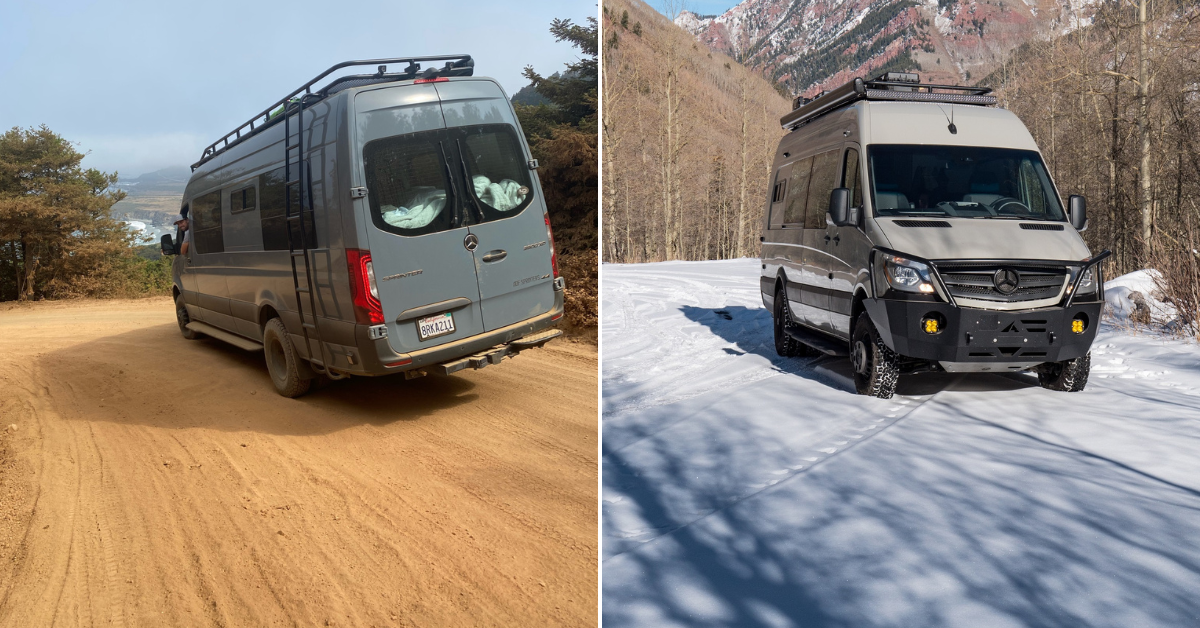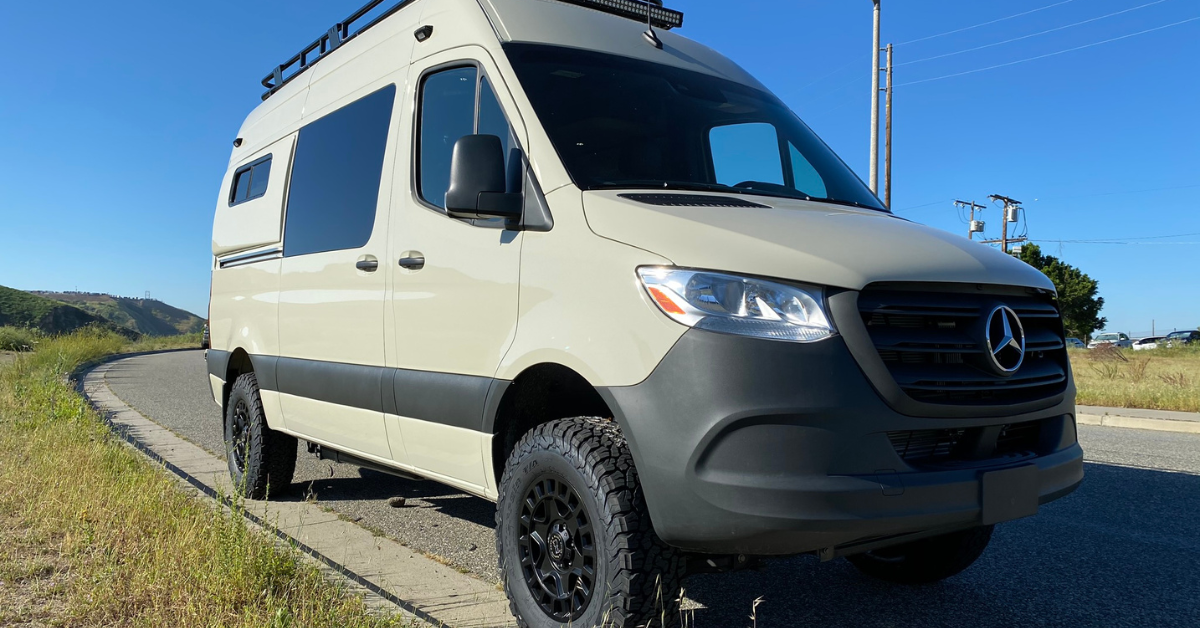Do You Need A 2WD or 4WD Van?
If you’re in the market for a Mercedes Sprinter Camper Van, it’s essential to understand which drive train will best suit your lifestyle. Just as you might deliberate over wheelbase lengths or engine types, choosing between a 2WD, AWD, or 4WD Sprinter van requires careful consideration.
In this blog, we will explore the different drivetrains in depth to help you better understand their differences and which decision is best for your lifestyle.
Something to note – From 2015-2022, Sprinter vans were typically badged on the rear door as “4×4.” Those from 2023 to the present are now referred to as “AWD,” for all-wheel drive. If you’re considering a Sprinter AWD conversion or wondering which option better suits your needs, check out our blog post “Is a Sprinter AWD Conversion Right for Me?” for an in-depth analysis and expert insights into making the best decision for your specific requirements.
What’s The Difference?
When choosing the drivetrain for your campervan, mobile office, or transportation vehicle, it’s important to consider your intended usage rather than solely focusing on internal build differences between two-wheel drive (2WD) and four-wheel drive (4WD) options. It’s worth noting that despite differences in drivetrains, the interior dimensions of the vehicles remain the same. Therefore, your decision should be based on where you plan to use the vehicle and what capabilities you require rather than concerns about internal space.
Two-wheel drive (2WD) vehicles, which are common in most passenger vehicles, distribute engine power to either the front (FWD) or rear (RWD) wheels. This setup results in lighter weight and typically offers better fuel efficiency, acceleration, and maneuverability.
On the other hand, Four-Wheel Drive (4WD) vans are sought after for their ability to carry heavier loads and navigate off-road terrain. In a 4WD van, power is evenly distributed among all four wheels, providing greater control in challenging conditions such as mud, ice, snow, or gravel.
* Sprinter 4wd are also heavier, giving you the weight needed for better traction. However, 4WD is not to be confused with all-wheel drive, and while these terms are often used interchangeably, there’s quite a difference between the two. For the intents and purposes of this blog, we will not go into too much detail about the intricate differences between 4WD and AWD systems.
What is your van’s purpose?
Every individual in the market for a van conversion is looking for the perfect vehicle that aligns with their lifestyle needs. Whether you’re converting a van into a mobile office, creating a business on wheels, or choosing a four-wheel-drive Sprinter conversion for family road trips and weekend adventures, selecting the right drivetrain is essential.
Below, we’ve listed some important factors to consider before finalizing your decision for your campervan conversion.

Where will you drive the van?
Deciding between a 2WD and 4WD for your Camper Van, mobile business, or transportation van boils down to knowing where you’ll be driving because that’s what really shapes how the van handles different situations.
If you’re planning on hitting rough terrain like gravel paths, dirt roads or rocky , a 4WD van is your go-to. It’s got a better grip and stability, so you won’t find yourself stuck. And when the weather turns bad, like in snow or heavy rain, the 4WD van gives you more control and traction than its 2WD. But if you’re sticking to roads or cruising on highways, the 2WD van might be the better fit. It tends to be more cost-effective to run and is gentler on fuel consumption.
Many of our customers aspire to venture off-road and explore remote areas. Fortunately, most of our preferred destinations and national parks are reachable via paved roads. Even if not, the paths typically consist of easily navigable gravel roads that pose no significant challenge to the average passenger vehicle.
* Always remember that if you’re traveling a new route or exploring a new destination, it’s essential to do your research beforehand and bring the tools you need to help you overcome any potentially challenging situations regardless of the drivetrain.
What conditions will you face?
So once you understand where you’ll be driving your van, you can then anticipate the conditions you’ll face. For example, suppose you live in colder regions, where snow and icy conditions occur frequently. In that case, a 4WD Sprinter is preferred because it will handle those conditions better than a 2WD, where you may need to add chains during extreme conditions. However, if you live in a more urban and metropolitan area, then a 2WD will suffice.
Cost
When comparing the cost between a two-wheel drive (2WD) Sprinter and a four-wheel drive (4WD) Sprinter, there’s a notable price difference. Let’s break it down with an example:
- The 2022 2500 144 High Roof with a 4-cylinder diesel engine and 2WD is priced at $47,920.
- Meanwhile, the 2022 2500 144 High Roof with a 6-cylinder diesel engine and 4WD is priced at $56,420.
- This shows an $8,500 disparity between the 2WD and 4WD versions of the Sprinter.
* It’s important to understand that if you haven’t made a decision regarding the engine type for your Sprinter van, there’s a key distinction: While both 2WD and 4WD/AWD Sprinter vans can be equipped with a diesel engine, only the 2WD version can accommodate a gas engine.
Due to extra components, maintaining a 4WD Sprinter can be costlier than a 2WD. For example, the additional axle requires frequent fluid replacements, increasing maintenance expenses. Also, the 4WD system’s continuous support of the rear axle leads to higher fuel consumption, especially on long trips. Choosing a 2WD Sprinter can yield substantial savings, particularly in fuel costs, with much better gas mileage than the 4X4/AWD vans.
4WD and 2WD Vans Availability
As previously mentioned, there is a significant demand for 4WD Sprinter vans. If you’re considering a Mercedes-Benz Sprinter with four-wheel drive, be prepared for a considerable wait. Depending on your location and the availability of the van, you could be looking at a waitlist of up to six months. While some individuals are willing to travel to where the van is accessible, this isn’t feasible for everyone. Alternatively, 2WD Sprinters are much more readily available.
 Resale Value
Resale Value
Are you the kind of owner who plans to drive a vehicle until it’s run its course, or do you prefer to sell it off after 5 to 10 years? If you lean towards the latter, campervans with 4WD usually sell quicker and at higher prices than their 2WD counterparts.
Often, the extra resale value can compensate for the initial investment in the 4WD Campervan. However, even if you never plan to use 4WD when buying the van initially, it could still be a worthwhile investment in the long term.
The Verdict
So which drivetrain is more conducive to your lifestyle?
While many people would prefer a 4X4 Sprinter Adventure Van, it’s not always necessary, and many of our clients realize most of their adventures will only require 2WD capabilities. If you’re still indecisive, we’d be happy to speak with you and help you choose the correct drivetrain for your custom campervan.
To see which Sprinter Vans we currently have available, visit our Sprinter Vans For Sale Page and/or reach out to our team at [email protected].
Sprinter 4wd Conversion FAQs
How much does it cost to convert a Sprinter van to 4×4?”
The cost to convert a Sprinter van to 4×4 can vary depending on factors such as the specific conversion kit chosen, labor costs, and any additional modifications desired. Generally, sprinter 4wd conversion costs can range from $7,000 to $15,000 or more.
Do any cargo vans come stock with either 4×4 or AWD?
Yes, some cargo vans are available from the factory with either 4×4 or AWD options. For example, the Mercedes-Benz Sprinter and Ford Transit offer factory-installed 4×4 systems as optional upgrades.
What 4×4 or AWD camper van would you recommend?
Depending on your preferences and budget, there are several excellent options for 4×4 or AWD camper vans. Some popular choices include the Mercedes-Benz Sprinter 4×4 and Ford Transit AWD. Each vehicle offers varying levels of off-road capability, comfort, and customization options for camper van conversions.
How can I explore off-road terrain without opting for a 4WD campervan?
If you want to navigate rocky roads without a 4WD campervan, consider outfitting your 2WD campervan with all terrain tires for enhanced traction. Also, increasing your ground clearance through a suspension upgrade, particularly at the front and rear, can help you tackle uneven terrain more effectively. Additionally, prioritizing front-wheel drive can provide better handling on challenging surfaces.



